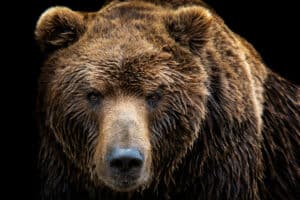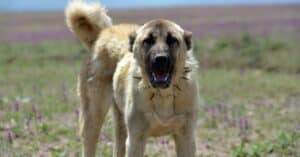Key Points:
- The largest species of bear, polar bears, generally weigh twice or even over five times as much as the Floridian black bear, which weighs about 300 pounds.
- These hypercarnivorous apex predators are perfectly adapted to their environment with thick insulating blubber and wide paws for swimming and distributing their bulk across the ice.
- Male polar bears generally weigh 1,500 pounds at their heaviest; however, the largest known specimen weighed significantly more (it was about the weight of 11 men!).
Polar bears are not only the largest bears in the world, but they are also the largest carnivores on land! These magnificent creatures are admired for their beautiful white coats and their particularly adorable little cubs. Interestingly, a polar bear’s famous white fur has no white pigment. The outer layer of fur is called guard hair. In polar bears, the guard hairs are translucent and appear white because of how they reflect light. This is similar to how snow appears white despite having no pigment. What other surprising information is there on polar bears? We’ll find out in this article as we explore the world’s largest polar bear ever recorded!
Why Are Polar Bears So Large?
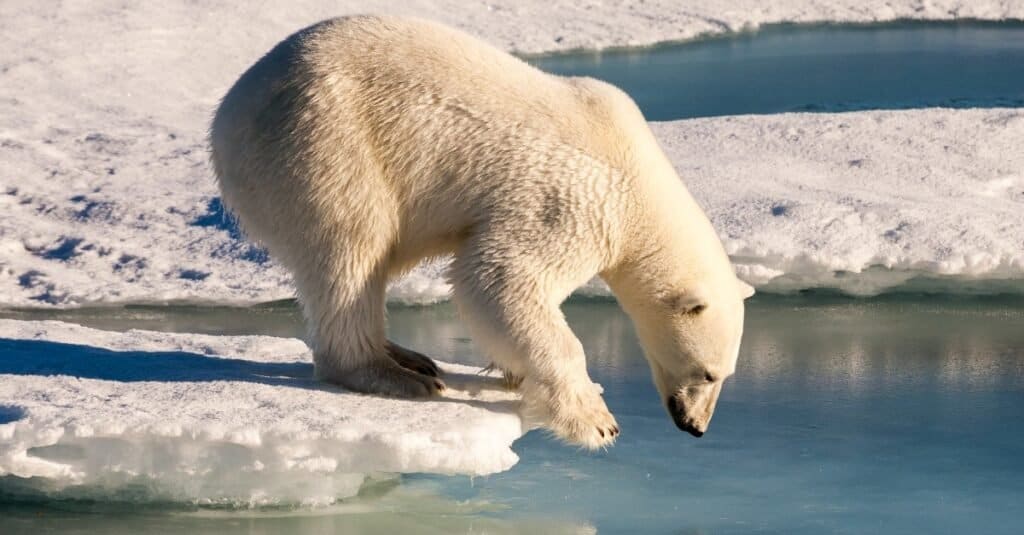
A polar bear is insulated by fur, a thick, dense coat of underfur as well as an outer coat of guard hairs, and fatty tissue.
©Mario_Hoppmann/Shutterstock.com
Polar bears inhabit the arctic circle including territories of Canada, Greenland, Norway, Russia, and the United States in parts of Alaska. The temperature in the Arctic Circle is influenced primarily by the surrounding seawater which is 28.8 degrees Fahrenheit (-2 degrees Celsius) before it freezes. The average atmospheric temperature in the winter is between -22 and -31 degrees Fahrenheit (-30 to -35 degrees Celsius).
In the animal kingdom, different evolutionary trends relate body size to ecology. Bergmann’s Rule states that animal species in colder climates will be larger than related species in warmer climates. For example, a male polar bear (Ursus maritimus) typically weighs between 770 and 1,540 pounds. This is much larger than its southern cousin the Floridian black bear (Ursus americanus floridanus) which weighs 300 pounds on average. Size and climate are correlated because a larger, rounder animal has a lower surface area to volume ratio. With less exposed surface and a larger volume, there is less area available for heat to escape and more volume available to conserve heat. Heat conservation in the cold Arctic environment is one reason why polar bears are so big.
Polar bears are also very large due to the amount of insulation they have. Polar bears have a thick, dense coat of underfur as well as an outer coat of guard hairs. Beneath their fur, these bears have a 4-inch (10 centimeters) thick layer of fatty tissue. This fat and fur insulate polar bears from the extremely cold temperatures the inhabit.
How Do Polar Bears Maintain Their Weight?
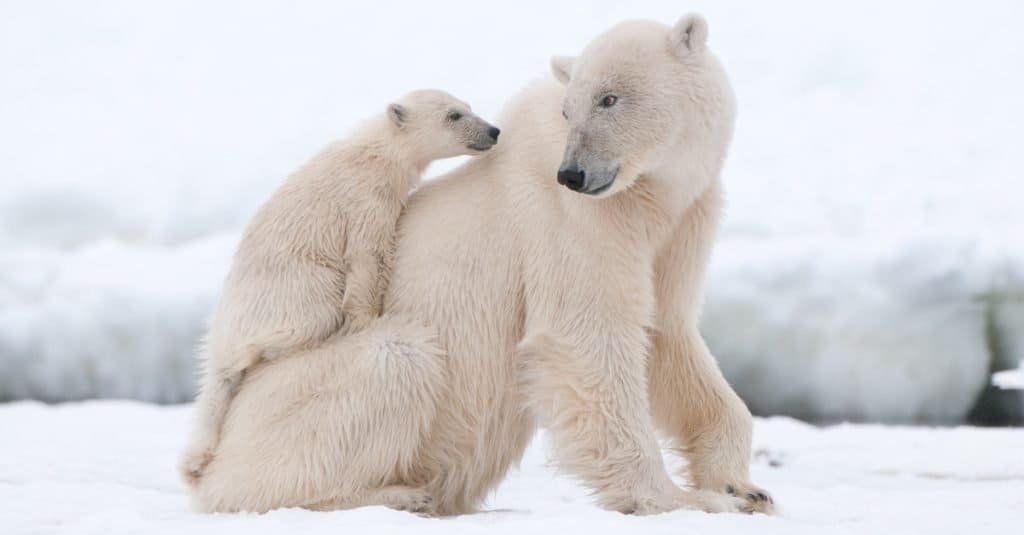
A female polar bear weighs 330-550 pounds, but doubles in size when pregnant and can weigh up to 1,100 pounds.
©Gecko1968/Shutterstock.com
Polar bears are apex predators considered “hypercarnivorous”. An animal classified as a hypercarnivore has a diet consisting of at least 70% meat. A polar bear is the most carnivorous bear with a diet of 90% meat! This is in part due to the lack of vegetation in an arctic ecosystem. In comparison, the grizzly bear is the least carnivorous bear with a diet of only 10% meat.
Polar bears primarily eat seals and do so typically by guarding a hole in the ice until a seal emerges. This is an effective hunting method because of their incredible sense of smell. Polar bears can smell a seal up to a mile away or beneath 3 feet of snow. They can smell a seal’s breath, locate it, and pull it out from below the ice. The skin and blubber of seals provide a high-caloric diet that helps a polar bear maintain its weight.
A female polar bear’s weight fluctuates greatly throughout her lifetime. A mature female typically weighs between 330 and 550 pounds. Male polar bears are much larger and therefore exemplify sexual dimorphism, where the sexes have different physical traits. When a female is pregnant, however, she doubles in size and can weigh up to 1,100 pounds!
How Do Polar Bears Get Around Being So Big?
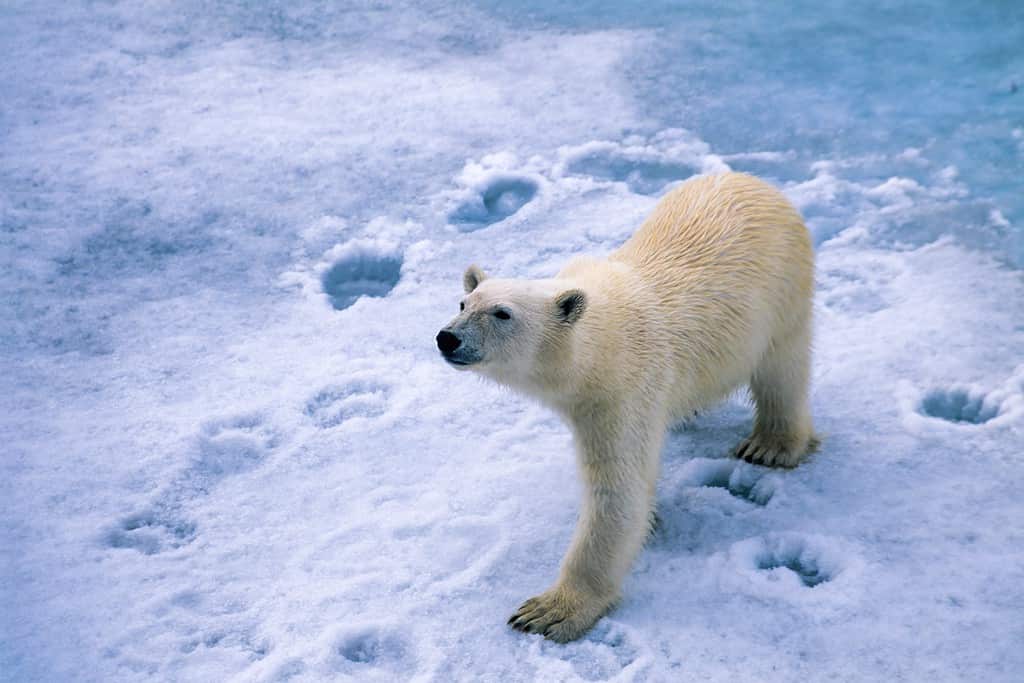
Polar bears are the only bears considered marine mammals, with paws that are around 12 inches across.
©Lasse Johansson/Shutterstock.com
Polar bears are classified as marine mammals because they spend a significant amount of time at sea. They have massive paws about 12 inches across that assist them in swimming. The large amount of fat insulating the polar bear also contributes to its ability to swim. The extra fat makes the bear more buoyant and allows for it to swim greater distances. Polar bears are incredible swimmers capable of swimming for days. The furthest a polar bear has ever been recorded swimming was a female in the Bering Sea. She swam for nine consecutive days, spanning 400 miles, to reach distant ice.
Polar bears also travel extensively on land. Their big paws are helpful on snow and thin ice because they distribute their weight over a larger area, similar to snowshoes. Polar bears typically walk quite slowly, but they can run at speeds up to 25 miles per hour. While polar bears usually remain within a home range, the furthest recorded distance a polar bear has traveled in a single trip was a female trekking 2,980 miles.
What Is the Largest Polar Bear Ever Recorded?
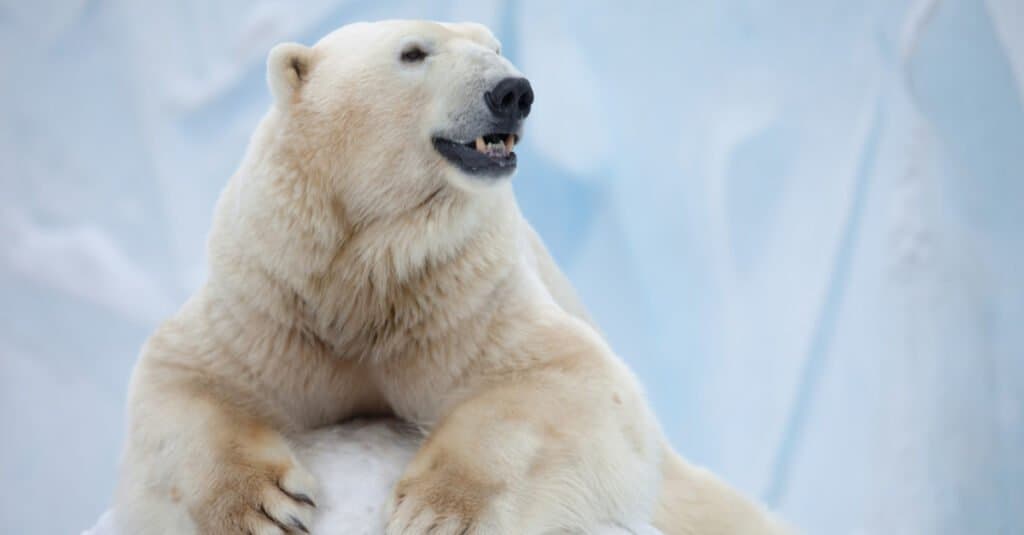
Polar bears are the world’s largest bear, with the largest in the world weighing 2,209 pounds.
©Zhiltsov Alexandr/Shutterstock.com
The largest polar bear in the world was a whopping 2,209 pounds!
With the average man weighing 200 pounds, this bear was the size of 11 grown men! This polar bear was spotted in Kotzebue Sound, Alaska in 1960. It stood an impressive 11 feet 1 inch tall when on its hind legs. In comparison, the average male polar bear typically stands 8 feet tall on its hind legs. Unfortunately, this humungous bear was shot and mounted. Polar bear sightings in Kotzebue Sound are not incredibly common because it is a transitional climate zone. Polar bears are generally considered the largest bear species, although Kodiak bears can be very close in size.
How Are Polar Bears Doing Today?
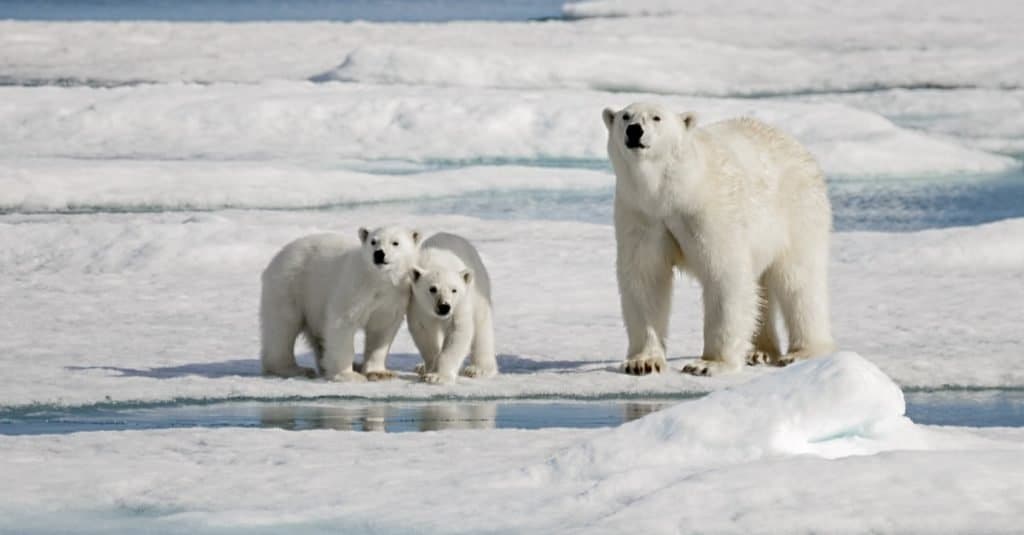
Melting ice caused by climate change is a serious threat to polar bears.
©Alexey Seafarer/Shutterstock.com
Polar bears are currently listed as a Vulnerable species and are at severe risk due to habitat loss resulting from climate change. The ice that polar bears live on is melting at record speeds because of increasing global temperatures. Increases in temperature earlier in the year prevent polar bears from creating sufficient fat reserves necessary to survive a period of food scarcity. Melting ice also forces polar bears to swim longer distances which causes fatigue and drowning.
Polar bears can live as long as 20 or even 30 years. However, because of environmental factors that are limiting their food supply and fat reserves, few polar bears live longer than 15-18 years. In captivity, though, polar bears can live up to 40 years because of carefully controlled diet and conditions. Nonetheless, some scientists predict polar bears could become extinct by 2100.

Polar bears are perfectly adapted to their forbidding, harsh icy habitat.
©Lamberrto/Shutterstock.com
The photo featured at the top of this post is © GTW/Shutterstock.com
Thank you for reading! Have some feedback for us? Contact the AZ Animals editorial team.



